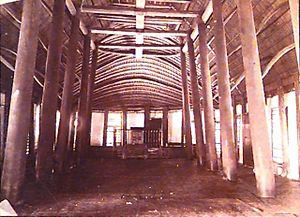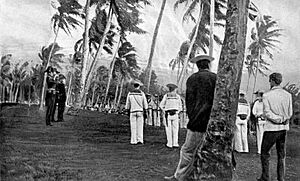History of Niue facts for kids
The history of Niue tells the story of this small island nation and its people. Niue is a beautiful island in the Pacific Ocean. Its first settlers were brave Polynesian sailors who arrived from Samoa around 900 AD. Later, in the 1500s, more people came from Tonga.
The first European to see Niue was Captain James Cook in 1774. He was on his second trip exploring the Pacific. However, he couldn't land because the local people strongly resisted. Later, in 1830, a missionary named John Williams was the first European to step foot on the island.
After many years of British missionaries working there, the local kings of Niue asked for British protection in 1879. In 1900, Lord Ranfurly, who was the Governor of New Zealand, officially announced that Britain now ruled Niue. This meant Niue became a protectorate of New Zealand.
Niue faced a sad loss during World War I. About 150 Niuean men, which was 4% of the island's population, went to fight in France with the New Zealand army. Sadly, almost none of them came home. World War II did not directly affect the island.
In 1974, Niue became a self-governing nation. This means it makes its own rules. Since then, the number of people living on the island has become smaller. Many people have moved away because of strong natural disasters and not enough job chances.
Contents
Early Days of Niue
For a long time, Niue did not have one single leader or government for the whole island. Instead, different chiefs and family leaders made decisions for their own groups of people.
Around the year 1700, the idea of having a king started in Niue. This likely happened because of contact with people from Samoa or Tonga. After this, a series of kings, called patu-iki, ruled the island. The very first king was named Puni-mata.
Europeans Arrive in Niue
Captain James Cook was the first European to see Niue in 1774. He tried to land on the island, but the local people were very protective and stopped him. Because of their strong resistance, Cook called Niue the Savage Island.

Christian missionaries from the London Missionary Society arrived later. By about 1846, most of the people on the island had become Christians. Tui-toga, who was king from 1875 to 1887, was the first Christian king of Niue.
In July 1849, Captain John Erskine visited the island on his ship, the H.M.S. Havannah.
Becoming a British Protectorate
In 1887, King Fataaiki of Niue wrote to Queen Victoria of the United Kingdom. He asked for Niue to be protected by Britain. However, his request was not accepted at that time.
Ten years later, in 1900, Niue asked again. This time, the island officially became a British protectorate. This meant Britain would protect Niue. The very next year, in 1901, Niue was joined with New Zealand.
Niue is quite far away from other islands. Also, its people have different customs and language from those in the Cook Islands. Because of these differences, Niue was managed separately from the Cook Islands.

Niue and World War I
During World War I, 148 men from Niue joined the New Zealand army. This was about 4% of everyone living on the island. They were sent to Egypt in February 1916.
However, many of the Niuean soldiers became sick. By April, more than half of them were in the hospital. They were then moved to Northern France in April 1916, but illness was still a big problem there.
By the end of May, it was decided that the Niuean soldiers would leave the fighting areas. They were sent to Hornchurch in England, and then they returned to New Zealand by the end of June.
Niue Becomes Self-Governing
Niue gained its independence in 1974. It chose to be in a free association with New Zealand. This means Niue handles most of its own affairs, but New Zealand helps with its military and foreign relations.
Niue had been offered this independence earlier, in 1965. The Cook Islands accepted it then, but Niue asked to wait another ten years.
People from Niue are still citizens of New Zealand. They use regular New Zealand passports. Niueans can vote or run in elections in either Niue or New Zealand if they meet the usual rules for living there.
Niue uses New Zealand money. However, it prints its own postage stamps. Stamps from New Zealand cannot be used in Niue, and Niuean stamps cannot be used in New Zealand.
Niue's Recent History
In January 2004, a very strong cyclone called Cyclone Heta hit Niue. This storm was devastating and left 200 of the island's 1600 people without homes.
After the cyclone, some people decided not to rebuild their homes on the island. New Zealand's Foreign Affairs Minister, Phil Goff, wondered if Niue could still be a self-governing nation if too many people left. He worried there might not be enough people to keep basic services running.
However, Niue's Premier, Young Vivian, quickly said that Niue would definitely not change its relationship with New Zealand.
The number of people living on the island continues to go down. The population was highest in 1966 with 5,200 people. By 2000, it was 2,100. Many people have moved to New Zealand.
See also
 In Spanish: Historia de Niue para niños
In Spanish: Historia de Niue para niños
- Postage stamps and postal history of Niue
- List of resident commissioners of Niue

